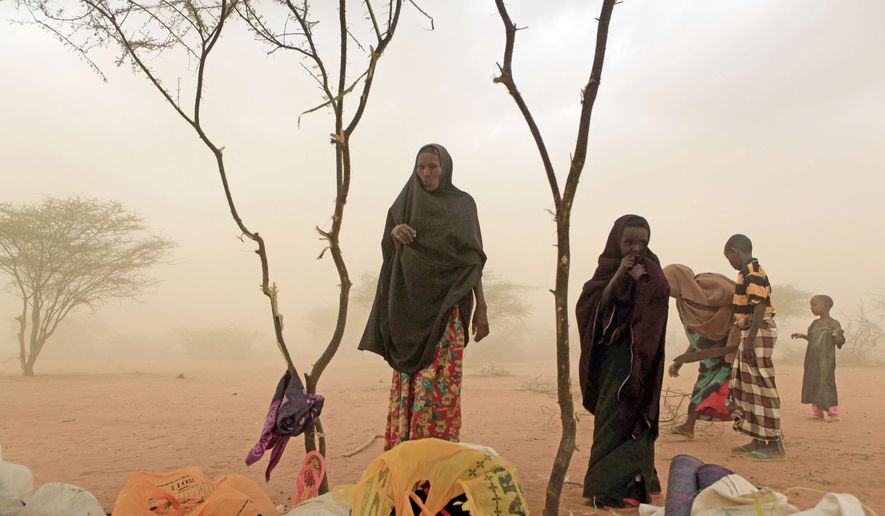KAMPALA, Uganda — The worst drought to hit the Horn of Africa in 60 years is creating a vast humanitarian crisis and throwing the economies of the region into chaos.
“Food prices have gone up … and people’s assets, primarily livestock, have gone down,” said Alun McDonald, a spokesman for the international charity Oxfam.
The crisis is worst in Ethiopia, Kenya and Somalia, the latter being the hardest-hit country in a drought affecting more than 10 million people.
The area where the three countries meet has had little to no rainfall in more than two years, and as much as 85 percent of each country’s workforce relies on agriculture for their livelihood. The U.N. reported in January that all crops in small farming areas in the region had failed.
The price of corn in Kenya is up as much as 160 percent, while milk costs three times more than when the drought began three years ago. Sorghum in Somalia has skyrocketed 240 percent, depriving cattle and goat herders of a source of feed for their livestock.
The animals are often emaciated, and their value has plummeted as much as 50 percent. The roads that millions of Somalis travel on their way to refugee camps in Kenya are littered with the skeletal remains of cows and camels.
The shortage of livestock is causing a rippling effect by crippling the wholesale market in the cities.
“Lots of pastoralists [herders] rely on trading animals for food rather than paying in cash, but the terms of trade have decreased significantly,” said Mr. McDonald, who is working in the drought-hit areas of northeastern Kenya.
Before the drought, a herder would get about 100 pounds of corn for one goat. Now, he is getting about half that amount. Camels in some rural parts of Kenya also are worth about half of their value, Mr. McDonald said.
The drought also is wrecking Kenya’s tea and coffee businesses. The Tea Board of Kenya expects a 12 percent fall in prices, while coffee growers who supply companies such as Starbucks fear a decline in exports of 27 percent. Kenya relies on agriculture for about 25 percent of its $32 billion economy.
Prices for food and nonalcoholic drinks are up 22.5 percent in Kenya, and transportation costs have soared by 22.7 percent.
In Ethiopia, the annual inflation rate hit 38 percent in June, threatening an economy that depends on agriculture for 43 percent of its $30 billion gross domestic product.
Somalia has been the most devastated by the drought, with tens of thousands making a desperate monthlong march to an overcrowded refugee camp in Kenya.
The country also is beset by al-Shabab, an Islamist terrorist gang that until recently has refused to allow foreign aid workers into the areas it controls. Somalia has lacked a functioning government for about 20 years.
“I believe Somalia represents the worst humanitarian disaster in the world,” said Antonio Gutterres, director of the U.N. refugee agency, after returning from the region over the weekend.
Mark Bowden, the top U.N. official in charge of humanitarian aid in Somalia, said Tuesday that some southern parts of the country are suffering from famine, the Associated Press reported.
Famine is officially defined as when two adults or four children per 10,000 people die of hunger each day and a third of children are acutely malnourished.
Mr. Bowden said that, in some areas of Somalia, six people a day are dying and more than half of the children are acutely malnourished, the AP reported.
The economic upheaval in Ethiopia, Kenya and Somalia is expected to cause financial disruption as far away as Uganda, which is feeling the lack of rain.
Uganda’s Finance Ministry last month predicted an annual growth rate of 6.3 percent, slightly lower than its previous forecast of 6.4. But the ministry expects a 15.8 percent decline in cash crops such as coffee, cotton and sugar cane.
Jared Osoro, a senior research economist at the East African Development Bank in Kampala, said the fate of the livestock herders is linked to the industrialized countries in other parts of Africa.
“Because so much of their livestock has been decimated, the livelihoods of the wholesalers they sell to are being affected,” he said.
Mr. Osoro also worried about inflationary pressures on Uganda because of an increased demand for Ugandan goods from countries hit hardest by the drought.




Please read our comment policy before commenting.